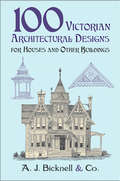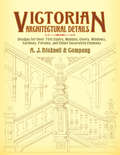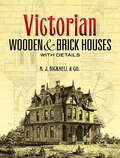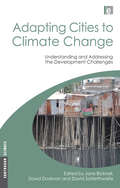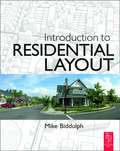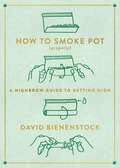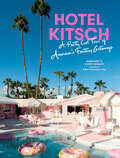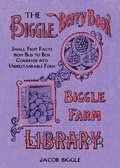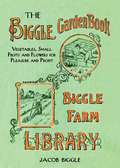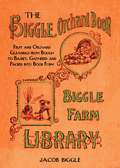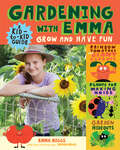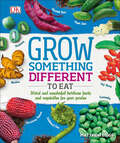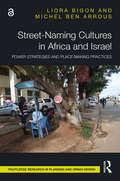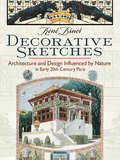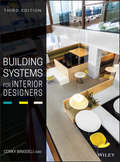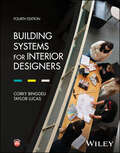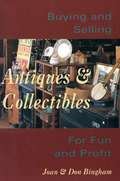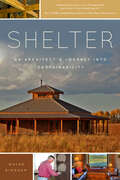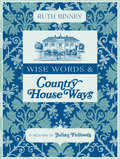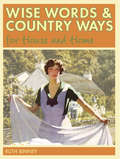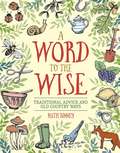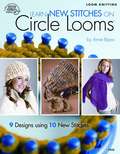- Table View
- List View
100 Victorian Architectural Designs for Houses and Other Buildings (Dover Architecture)
by A. J. Bicknell Co.Originally published in 1878, this now-rare collection of designs supplies views of a remarkable variety of modestly priced structures: houses, villas, cottages, many others. Handsome drawings of perspective views and elevations, some of which include floor plans, plus suggestions for interior design. 98 black-and-white illustrations.
Victorian Architectural Details: Designs for Over 700 Stairs, Mantels, Doors, Windows, Cornices, Porches, and Other Decorative Elements
by A. J. Bicknell Co.Hundreds of rare illustrations depict wide range of design alternatives for prospective homeowners and other customers of the late 19th century. While the collection includes elevations and floor plans for a variety of handsome, private residences and commercial structures, the emphasis is on architectural details — from dormer windows to balconies.
Victorian Wooden and Brick Houses with Details
by A. J. Bicknell Co.This vintage volume offers a treasure trove of floor plans, elevations, and details of residences and public buildings. Artists, architects, and historians alike will find it an endless source of inspiration.Featured buildings include villas, cottages, and farm houses as well as churches, schools, banks, and many other structures. Eighty-one remarkably detailed illustrations capture the elaborate, distinctive beauty of Victorian-era cornices, staircases, gables, verandas, doors, dormers, and other architectural elements. In addition, a fascinating "Specifications" section highlights construction guidelines for masons, bricklayers, and carpenters.
Adapting Cities to Climate Change: Understanding and Addressing the Development Challenges (Earthscan Climate Ser.)
by Jane Bicknell David Dodman David SatterthwaiteThis volume brings together, for the first time, a wide-ranging and detailed body of information identifying and assessing risk, vulnerability and adaptation to climate change in urban centres in low- and middle-income countries. Framed by an overview of the main possibilities and constraints for adaptation, the contributors examine the implications of climate change for cities in Africa, Asia and Latin America, and propose innovative agendas for adaptation. The book should be of interest to policy makers, practitioners and academics who face the challenge of addressing climate change vulnerability and adaptation in urban centres throughout the global South. Published with E&U and International Institute for Environment and Development
Introduction to Residential Layout
by Mike BiddulphIntroduction to Residential Layout is ideal for students and practitioners of urban design, planning, engineering, architecture and landscape seeking a comprehensive guide to the theory and practice of designing and laying out residential areas.Mike Biddulph provides a clear and coherent framework from which he offers comprehensive practical advice for designers of housing developments. Referring to a wealth of international examples, this is a richly illustrated, accessible resource covering the whole range of issues that should be considered byanyone engaging in the planning and design of a new residential scheme.A successful residential development must work on many levels – financial, social and environmental. This book includes analysis of commercial viability, the importance of place making, environmental sustainability and designing accessibility. Mike Biddulph details successful approaches to designing out crime and maximising permeability as part of an integrated approach to urban design.Highly illustrated throughout, this work will show you how to turn design aspirations and principles into practical design solutions. Written without preconceptions, Introduction to Residential Designhighlights the strengths and weaknesses of particular design solutions to encourage both depth of thought and creativity.Mike Biddulph is Senior Lecturer in Urban Design at Cardiff University
How to Smoke Pot (Properly): A Highbrow Guide to Getting High
by David BienenstockOnce literally demonized as "the Devil's lettuce," and linked to all manner of deviant behavior by the establishment's shameless anti-marijuana propaganda campaigns, cannabis sativa has lately been enjoying a long-overdue Renaissance. So now that the squares at long last seem ready to rethink pot's place in polite society, how, exactly, can members of this vibrant, innovative, life-affirming culture proudly and properly emerge from the underground--without forgetting our roots, or losing our cool?In How to Smoke Pot (Properly), VICE weed columnist and former High Times editor David Bienenstock charts the course for this bold, new, post-prohibition world. With plenty of stops along the way for "pro tips" from friends in high places, including cannabis celebrities and thought leaders of the marijuana movement, readers will learn everything from the basics of blazing, to how Mary Jane makes humans more creative and collaborative, nurtures empathy, catalyzes epiphanies, enhances life's pleasures, promotes meaningful social bonds, facilitates cross-cultural understanding, and offers a far safer alternative to both alcohol and many pharmaceutical drugs.You'll follow the herb's natural lifecycle from farm to pipe, explore cannabis customs, culture and travel, and discover how to best utilize and appreciate a plant that's at once a lifesaving medicine, an incredibly nutritious food, an amazingly useful industrial crop, and a truly renewable energy source. You'll even get funny and informative answers to burning questions ranging from: How can I land a legal pot job? to Should I eat a weed cookie before boarding the plane? In two-color, with charts and illustrations throughout, How to Smoke Pot (Properly) is truly a modern guide to this most revered herb. And remember, marijuana has the potential to help us live more meaningful, satisfying and authentic lives, and create safer, happier, more harmonious communities, but first we must learn to consume this miracle plant properly.From the Trade Paperback edition.
Hotel Kitsch: A Pretty Cool Tour of America's Fantasy Getaways
by Margaret Bienert Corey BienertA visual celebration of the best fantasy suites and honeymoon hotels across America and beyond, from the creators of A Pretty Cool Hotel Tour In 1963, the savvy owners of the Cove Haven Resort in the Poconos unveiled their heart-shaped tub. Like Elvis Presley and Playboy magazine, it launched a postwar phenomenon that defined a new era of pop pleasure: the honeymoon hotel. Destinations across the country were soon racing to catch up, installing not just heart-shaped tubs but all types of over-the-top design flourishes, from pink shag carpeting to immersive worlds worthy of a Broadway stage set, in order to create a sense of romance, fantasy, even adventure. From the photographers and inveterate travelers behind the social media sensation A Pretty Cool Hotel Tour, Hotel Kitsch celebrates dozens of creative, nostalgic, one-of-a-kind hotels that span the heart of the Poconos and across the United States to Mexico, Spain, and the UK. Discover, in the middle of Iowa, a jungle room with fake trees and foliage surrounding the bed as if it had taken its cue from Where the Wild Things Are. Or Jules&’ Undersea Lodge in Key Largo where the rooms are reached by scuba diving. An Arctic Cave room at a hotel in Kentucky with its carved blue walls and not a window to be found. And on the California coast, the iconic Madonna Inn featuring 110 rooms, each themed and no two alike. Along the way, authors Margaret and Corey Bienert uncover too many wild details to mention, including unconventional beds (a Cadillac, a clamshell, a sandwich), mirrors on mirrors on mirrors, in-room swimming pools, full suits of armor, and fiber-optic star ceilings. While it&’s not a travel guide, every destination in Hotel Kitsch is open for business. Time to check in.
The Biggle Berry Book: Small Fruit Facts from Bud to Box Conserved into Understandable Form
by Jacob Biggle"The only just and true way for an honorable and manly man is to grow them, and let everybody about the place have all he can eat. For the berry comes from the garden to the table in tempting and presentable shape, fit to grace the table of a king," writes Jacob Biggle in The Biggle Berry Book, which was first published in 1894. If you hate plunking down what seems like a king's ransom every time you buy a quart of berries at the local farmer's market, and if you've got a little land to spare, it might be time to grow your own.Jacob Biggle shows just how easy it is to raise your own nutrient-rich berries. While the book's emphasis is on more common fruit such as strawberries, raspberries, blackberries, currants, gooseberries, and grapes, there is also information from other berry growers living in all parts of America who raised less familiar varieties such as dewberries, juneberries, loganberries, mulberries, and mayberries. Biggle's trusty manual contains advice on, among other things:How to keep your berry patch pruned, cleaned, cultivated, and in good orderHow to protect your plants from fungus and insect damageThe best ways to pick, pack, and market your berries, if you're willing to part with them,Enhanced with color plates, beautiful engravings, and vintage photographs, The Biggle Berry Book is a treasure for anyone who appreciates the taste and freshness of homegrown fruit.
The Biggle Garden Book: Vegetables, Small Fruits and Flowers for Pleasure and Profit (Gardening In America Ser.)
by Jacob BiggleWhen The Biggle Garden Book was first published in 1908, most people were in the habit of raising their own food and flowers. Jacob Biggle felt that a gardener's success had to do with willpower and passion rather than acreage. "The man, woman or youngster who really wants a garden, will somehow manage to have a good one regardless of soil conditions, bad weather, measles in the family, or whether the area of ground at hand is a square acre or a square rod," he wrote encouragingly at the start of the book.That passion for gardening continues today in fields, backyards, and urban community plots across the United States. According to a poll taken in 2009 by the National Gardening Association, more than forty-three million households in the United States grow some of their own food. Learn how to do things the "old-school" way as Jacob and Harriet Biggle guide you through the fundamentals of:Soil preparation, sowing, and plantingHotbeds and cold framesFertilization, cultivation, and irrigationFlower gardening with old-fashioned favoritesGarden pests and friendsWith a resurgence in organic farming, heirloom varieties, and self-reliant living, The Biggle Garden Book is more valuable than ever because of the time-tested advice it offers.
The Biggle Orchard Book: Fruit and Orchard Gleanings from Bough to Basket, Gathered and Packed into Book Form (Gardening In America Ser.)
by Jacob Biggle"The first thing to do about starting an orchard is to plan for it," Jacob Biggle, the author of this handy little book, advises. "Put on your thinking-cap, study into the matter, and do not jump in the dark. A slow start is much better than a poor start. Harriet says that an orchard set in the right place, at the right time and of the right varieties, is worth just eleven times more than a hit-or-miss orchard. Where she secured the data for such exact figures, I do not know; but I am willing to admit that she is about right in this statement."Once you've followed Harriet's advice and determined the site for your orchard, the next task is to decide what kinds of trees to plant in it and learn how to care for them season after season. The Biggle Orchard Book includes everything you need to know about nearly every fruit tree under the sun, and also those that produce nuts. It includes instructions on:How to prune newly set treesWhen to pick fruitHow to pack fruit for the farmer's marketAnd much more!Written for backyard farmers, especially those interested in timeless orcharding techniques, The Biggle Orchard Book is an essential and charming addition to the home library.
Gardening with Emma: Grow and Have Fun: A Kid-to-Kid Guide
by Emma Biggs Steven BiggsThirteen-year-old Emma Biggs is passionate about gardening and eager to share her passion with other kids!Gardening with Emma is a kid-to-kid guide to growing healthy food and raising the coolest, most awesome plants while making sure there’s plenty of fun. With plants that tickle and make noise, tips for how to grow a flower stand garden, and suggestions for veggies from tiny to colossal, Emma offers a range of original, practical, and entertaining advice and inspiration. She provides lots of useful know-how about soil, sowing, and caring for a garden throughout the seasons, along with ways to make play spaces among the plants. Lively photography and Emma’s own writing (with some help from her gardening dad, Steve) capture the authentic creativity of a kid who loves to be outdoors, digging in the dirt. This publication conforms to the EPUB Accessibility specification at WCAG 2.0 Level AA.
Grow Something Different to Eat: Weird and wonderful heirloom fruits and vegetables for your garden
by Matthew BiggsDiscover more than 50 out-of-the-ordinary edibles, from cucamelons to strawberry popcorn, in this seed-to-plate guide that inspires you to cultivate amazing new fruit and vegetable crops.Whether you're a beginner and determined to make the most of limited space with a truly unique and heirloom harvest, or a seasoned grower looking to spice up your cooking with gourmet flavors, the step-by-step instructions give you the confidence to grow some unusually tasty crops. Choose from fruiting vegetables such as orange eggplants and hyacinth beans, salad greens such as fiddlehead ferns and sushi hostas, grains such as quinoa and chia, and luscious fruits such as honeyberries and white strawberries. All plants can be started indoors and transplanted, grown outdoors in the garden, or kept as houseplants. With versatile gardening advice for growing in a variety of spaces and situations, plus cooking suggestions and preserving options, a weird and wonderful harvest is guaranteed.
Street-Naming Cultures in Africa and Israel: Power Strategies and Place-Making Practices
by Liora Bigon Michel Ben ArrousThis book is focused on the street-naming politics, policies and practices that have been shaping and reshaping the semantic, textual and visual environments of urban Africa and Israel. Its chapters expand on prominent issues, such as the importance of extra-formal processes, naming reception and unofficial toponymies, naming decolonisation, place attachment, place-making and the materiality of street signage. By this, the book directly contributes to the mainstreaming of Africa’s toponymic cultures in recent critical place-names studies. Unconventionally and experimentally, comparative glimpses are made throughout between toponymic experiences of African and Israeli cities, exploring pioneering issues in the overwhelmingly Eurocentric research tradition. The latter tends to be concentrated on Europe and North America, to focus on nationalistic ideologies and regime change and to over-rely on top-down ‘mere’ mapping and street indexing. This volume is also unique in incorporating a rich and stimulating variety of visual evidence from a wide range of African and Israeli cities. The materiality of street signage signifies the profound and powerful connections between structured politics, current mundane practices, historical traditions and subaltern cultures. Street-Naming Cultures in Africa and Israel is an important contribution to urban studies, toponymic research and African studies for scholars and students. Chapters 1 and 2 of this book are freely available as a downloadable Open Access PDF under a Creative Commons Attribution-Non Commercial-No Derivatives 4.0 license available at http://www.taylorfrancis.com/books/e/9781003173762
Decorative Sketches: Architecture and Design Influenced by Nature in Early 20th-Century Paris
by René BinetAt the turn of the 20th century, artists and craftsmen throughout Europe and America were profoundly affected by a new art style that took its inspiration from nature. Generally referred to as Art Nouveau, the trend influenced all manner of creative types, from painters, illustrators, and architects to ironworkers, interior decorators, and designers of furniture and jewelry. Although broad and varied, the style is almost uniformly characterized by abstract, asymmetrical, curvilinear design. This "new art" both elevated the status of crafts to fine arts and brought objects into a harmonious relationship with their environment through the use of lines that were natural, vital, and, most importantly, organic.The decorative images in this volume, reproduced from a rare 1902 portfolio, reflect the era's exotic and imaginative approach to architecture and applied design. Sixty plates, 12 in full color and many with partial and varied color, exhibit the influence of the artwork of naturalist Ernst Haeckel on artist René Binet's designs, especially as related to Binet's "Monumental Door," prepared for the 1900 World's Fair in Paris. Illustrations reflecting the styles of Art Nouveau include a wealth of examples that range from doorbells and keys to stairways, fountains, jewelry, ceramics, and other items. Graphic designers, illustrators, architects, artists, and crafters will find this volume a rich source of ornamental ideas, authentic motifs, and design inspiration.
Building Systems for Interior Designers
by Corky BinggeliBuilding Systems for interior designersSecond EditionCorky Binggeli, asidThe updated guide to technical building systems for interior designersAs integral members of the building design team, interior designers share an increasingly complex and crucial role. Now revised in its second edition, Building Systems for Interior Designers remains the one go-to resource that addresses the special concerns of the interior designer within the broader context of the rest of the building design team. Building Systems for Interior Designers, Second Edition explains technical building systems and engineering issues in a clear and accessible way to interior designers. Covering systems from HVAC to water and waste to lighting, transportation, and safety, author Corky Binggeli enables interior designers to communicate more effectively with architects, engineers, and contractors; collaborate effectively on projects; and contribute to more accurate solutions for a broad range of building considerations.Among the many improvements in the Second Edition are: A deeper engagement with sustainable building design, giving the interior designer the resources needed to participate as part of a sustainable design team A reshaped structure that enhances the reader's understanding of the material Many more illustrations and explanatory captionsWith a host of features to make the book more up to date, easier to use, and more effective as an instructive guide, Building Systems for Interior Designers, Second Edition is a valuable book for students as well as a practical desktop reference for professionals.
Materials for Interior Environments
by Corky BinggeliOrganized by types of materials and applications, this guide helps designers successfully address material evaluation and selection of interior components. Engagingly written, highly detailed, and helpfully illustrated with more than 550 color illustrations, Materials for Interior Environments is a comprehensive guide to everything a designer needs to know about the materials available for interiors--from aesthetic qualities to manufacturing and fabrication, applications, installation and maintenance, and specifications for materials used in commercial and residential applications.
Building Systems for Interior Designers
by Corky Binggeli Taylor LucasBUILDING SYSTEMS FOR INTERIOR DESIGNERS Make design decisions informed by technical and structural knowledge with this essential guide Professional interior design demands more than simply an understanding of aesthetic and artistic considerations; it also requires a detailed understanding of building systems and their interactions. Design decisions must account for mechanical and electrical equipment, building components, and structural elements, all of which can potentially shape a designer’s work. Building Systems for Interior Designers has long stood as the key to understanding and evaluating these elements, particularly key building systems like HVAC and plumbing, and their impacts on interior design. This Fourth Edition is fully updated to fit the needs of the CIDA certified interior design program and the NCIDQ exam. The fourth edition of Building Systems for Interior Designers also includes: Updated information on sustainable and energy-efficient design Detailed coverage of topics including security concerns, fire safety, and designing secure spaces Classroom supplements including sample construction documents, chapter specific discussion questions, and more Building Systems for Interior Designers is ideal for students in interior design courses and new professionals studying for NCIDQ exams.
Buying & Selling Antiques & Collectibles
by Joan Bingham Don BinghamWritten for both beginners and experienced collectors, this guide provides descriptions of some of the more prized antiques and collectibles, and explains how to find them and how to resell them. The Binghams offer insiders' tips on cleaning and repair, auction strategies, how to set up displays and how to find the best markets for your wares.Buying & Selling Antiques and Collectibles is the indispensable guide for those who plan to start their own antiques business or who hope to make a little money from their hobby
Shelter: An Architect's Journey into Sustainability
by Wayne BinghamAfter practicing conventional glass, steel, and concrete architecture for more than thirty years, an award-winning architect discovers the concept of sustainable living and embarks on a journey that ends with his own strawbale home at the foot of the Grand Tetons. A complete source of information for sustainable and off-the-grid construction, Shelter explores the principles of sustainable living and then illustrates actual execution of those principles in the author's strawbale home. Both an exploration of sustainability from an architect's point of view as well as a practical reference for home builders, Shelter is an indispensable resource to those interested in leaving a smaller foot print on the environment. Follow the author from the beginning idea through the planning, designing, and constructing to the realities of living in his strawbale dream home.
Wise Words and Country House Ways
by Ruth BinneyThis charming guide to the world of the English country house reveals all the essential hints and tips for living in and running a great house, whether you were lord, lady, maid or cook. By esteemed author Ruth Binney and with a Foreword by Julian Fellowes, creator of the much-loved Downton Abbey. Discover the rules of etiquette and manners that existed both 'upstairs' and 'downstairs', the daily routines of servants, bygone housekeeping maxims for everyone from the scullery maid to the gardener, and learn how to prepare for a grand ball. The intricate way in which the country house worked is reflected in the six chapters of this book, beginning with Keeping House and progressing to The Daily Routine and The Country House Kitchen . Since correct behavior was so important to all activities of the house, A Matter of Manners addresses the essentials of etiquette, a theme that also extends into Leisure, Entertainment and Sport . Finally Garden and Grounds focuses on everything from the cultivation of exotic fruit for the table to brewing and the care of horses and other animals. With beautiful line drawings, Wise Words and Country House Ways will be fascinating for anyone who has wondered what it would be like to be served, or in service in a grand country house.
Wise Words & Country Ways for House and Home
by Ruth BinneyContains generations of advice on simple ways to run an environmentally-friendly home, based around well-known, and not-so-well-known, sayings. Everyone is keen to reduce their carbon footprint, conserve resources, eat and live more healthily. Ruth Binney's fascinating collection of traditional wisdom shares how our forbears lived well within the resources available.
A Word to the Wise: Traditional Advice and Old Country Ways
by Ruth BinneyIf you've ever wondered whether carrots improve your vision (they do) and why elephants have great memories, consult A Word to the Wise. You'll discover that it's never too late to learn from a proverb or an old wives' tale. This captivating book is a fascinating compilation of age-old expressions and customs, and its insights cover everything from health tips and kitchen tricks to gardening know-how and hints for predicting the weather.Folklorist Ruth Binney explains the truth behind such traditions as polishing windows with newspaper and blowing out birthday candles in a single breath. She also discusses whether classic adages are still relevant or, like eating oysters only in "R" months, their truths have faded with the passage of time. This charmingly illustrated volume of enduring wisdom makes a splendid keepsake as well as a fine gift.
Greenhouse Production
by Ronald J. BiondoGreenhouse Production is a comprehensive book based on the green¬house industry. It takes the reader beyond the most basic levels of horticulture. It includes botany and the production of floriculture crops.
Landscape Design, Construction, and Maintenance
by Ronald J. Biondo Charles B. SchroederNIMAC-sourced textbook
Learn New Stitches on Circle Looms (Loom Knitting)
by Anne Bipes9 new designs and 10 new stitches that can be done using circular or knitting looms.
